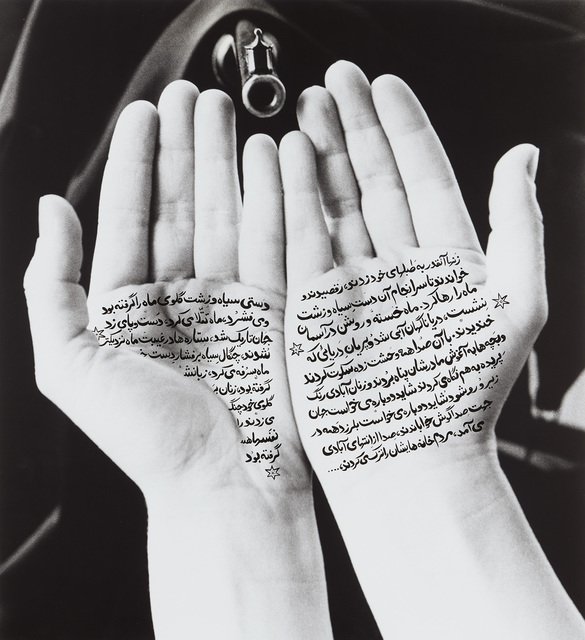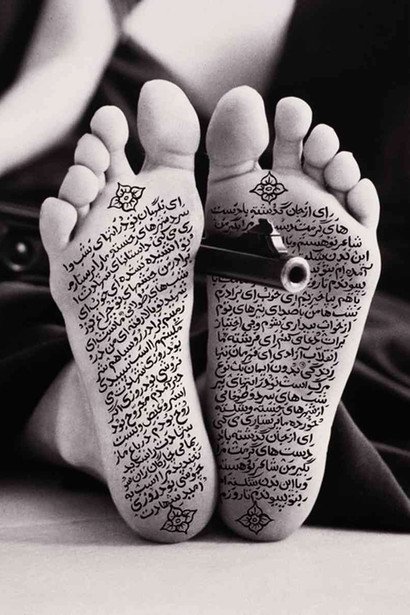Shirin Neshat was born in 1957 in Qazvin, northwestern Iran, capital of the province bearing the same name. She becomes internationally famous thanks to her films and photographic series, through which she explores the identity representations of the feminine and masculine genders in the complex Iranian culture, paying particular attention to women and their role in islamic society. In 1974, having moved to New York for study purposes, she becomes exiled due to the advent of the Islamic revolution that prevented her from returning home until 1990. Upon her return to Iran the artist realises she’s completely changed, and this new awareness is reflected in her research, which gradually focuses on more delicate issues, such as the condition of women in today’s Islam. Shirin currently lives between New York and her hometown.

Shirin Neshat, Guardians of Revolution (from the Women of Allah series), 1994, Ink on gelatin silver print | Fonte: Artsy.net
Her favourite art tools are the camera and video recorders. It’s impossible to summarise in just a couple of minutes the scope and artistry of an internationally acclaimed artist such as Shirin. So I’ve decided to focus mainly on her first works entitled Women of Allah: a series of black and white photographs portraying veiled women figures, close-ups of female bodies (with special attention to face, hands and feet), on which the artists writes (in pen) verses of Iranian women poets (such as Forugh Farrokhazad, a young writer who died in a car accident in 1963), who challenge and question the stereotypical qualities assigned to Muslim women. The iconic photograph of this series, Rebellious Silence, has become the symbol of a revolt that women, not just Islamic women, are trying to implement in a society still deeply rooted in manifest chauvinism.
The photographic series Women of Allah covers a period of four years, from 1993 to 1997 and is the result of one her first visits back to her home country after her forced exile in America, following the advent of the Islamic Revolution in 1978. The war transformed the country from a monarchy to a Shiite Islamic Republic, whose constitution is based on Shari’ah Law. Before the revolution Iran was ruled by a dictator, Shah Mohammad Reza Pahlavi, who reigned as an undisputed ruler from 1941 until 1979. In history his dictatorship is known for the bloody repression of political and religious freedom and for the modernisation of the country according to Western cultural models.
Post-war Iran was an ally of Britain and the United States, and was markedly progressive in terms of women’s rights. However, in later years the regime became increasingly restrictive so that eventually the revolutionaries rose to abolish the monarchy in favour of a conservative religious government headed by Ayatollah Khomeini. The revolution of 1978 was the cause of profound political and social upheavals in Iranian society, as reflected in the work by Shirin, an artist unmistakably linked to her homeland.

Shirin Neshat, Rebellious Silence (Women of Allah series), 1994, BW-RC print ink photo by Cynthia Preston | ©Shirin Neshat courtesy Barbara Gladstone Gallery New York and Brussel | Fonte: Khan Academy
The series Women of Allah was made during Shirin’s stay in America, even though the focus is unmistakably on her native country, to which she has remained attached. Her work has been the subject of numerous solo shows and important exhibitions (including the Venice Biennale). The photographs Women of Allah were exhibited in a large retrospective collection at the Neue Galerie Graz, Austria, in 2018, demonstrating how they are still relevant even today (despite them being shot almost 30 years ago). Since 2005 Shirin Neshat is one of the artists exhibited in the Gladstone Gallery in New York, where she recently showed her latest installation: Land of Dreams.
The women portrayed in Women of Allah are the symbol of a silent struggle, made of rifles and glances that strike more than a bullet, against the women stereotypes imbued in today’s society; they are intense and provocative images. After the advent of the new religion-based regime, which forces Muslim women to cover themselves almost entirely to avoid attracting male attention, the most powerful communication tools become the small spaces that remain uncovered: the face, hands and feet. It is through them that the Iranian women represented by Shirin regain their identity, allowing them to change from objects of male to desire and become subjects, themselves. Although the series is not recent, the themes addressed by the artist are still extremely relevant, not just in Iranian society (which is admittedly a conservative one) but also in other societies that boast of being progressive and equal – though still have a lot of work to do to achieve this.

Shirin Neshat, Allegiance with Wakefulness (Women of Allah series), 1994, B&W RC print & ink. Courtesy of the Artist and Barbara Gladstone Gallery, New York and Brussels | Fonte: Kooness.com
Sitography:
Gladstone Gallery | Enciclopedia Treccani | Khan Academy
Ph. Credits | Shirin Neshat
Read other Focus on ZìrArtmag
Translated by Ludovica Sarti
